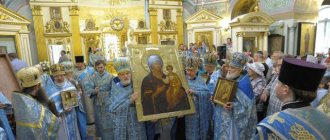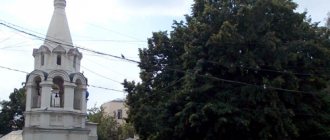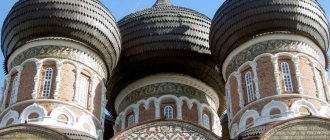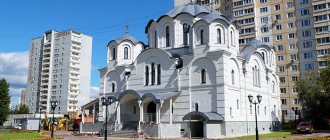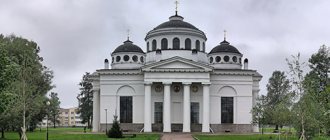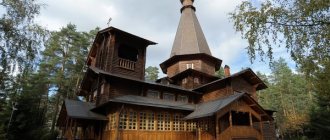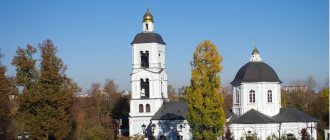The Church of the Smolensk Icon of the Mother of God arose despite the fact that during the reign of Catherine II there was a ban on the construction of new churches. This unusual white and pink church still operates in the city of Orel. It stands out against the backdrop of the city’s architecture, seeming like some kind of precious stone or exotic flower among the surrounding greenery. Let's take a closer look at its history.
| Church of the Smolensk Icon of the Mother of God | |
| A country | Russia |
| City | Eagle |
| Year of foundation | 1767 |
| Website | odigitriya-hram.ru |
| Abbot | Archpriest Nikolai Shumskikh |
The first church existed from 1767 to the 40s of the XX century
The Smolensk Church appeared here in 1767. Its main function is to resist schismatics in the vicinity of the city of Oryol and conduct a mission there among the Old Believers. To obtain permission to build a church, an application had to be submitted to Catherine II.
The Empress allowed construction. The church was located in the center of Streletskaya Sloboda. This name is no longer on the map. In fact, even in previous centuries it was not a specific place.
The fact is that the city developed and expanded, and the surrounding settlements were moved further and further, where they were rebuilt with the same name.
The land on which the church was erected was owned by a peasant peasant named Ivan Chepakhin.
The construction was headed by the elder Ivan Elenin, and it was financed by donations.
We know several details about the appearance of the first church:
Altar. It was oriented towards the East - as required by the Orthodox tradition.
Bell tower. The land of the single-yard peasant turned out to be sufficient for its construction.
Garden. In the place where it was located, the current Church of the Smolensk Icon of the Mother of God was erected.
Thrones. There were three of them:
- Smolensk Icon of the Mother of God;
- Dmitry Solunsky;
- Miraculous Image.
The building was gradually completed and expanded.
In 1777, services began to be held.
This building was destroyed in the early 40s of the 20th century, even before the war. Then they switched to the bell tower and dismantled it in 1951. In its place, the Komsomolsky cinema was built.
It stood until 1995, but then the building was abandoned. Subsequently, they tried to rebuild it, but the idea did not end in anything. And now on the site of the bell tower there is an unfinished building.
Once there was a bell tower here, then there was a cinema, and now there is an unfinished building
The second church was completed in 1889, but it ceased to function in 1938
In parallel with the reconstruction of the old temple, it took almost forty years to build a new one. The initiator of this idea was the merchant Ivan Serebryannikov.
In 1852, his will was made public, in which the merchant allocated a large sum and regular interest for the construction of a new church in honor of the icon of the Smolensk Mother of God.
The new church was built in the garden of the old one.
Just four years later the finished project appeared, and in 1857 the foundation was laid.
The second temple was erected in 1889. Its bell tower was completed only nine years later.
There was a school for the poor here.
Two holy icons were kept in the church:
- Martyr Menas of Alexandria;
- Smolensk Mother of God.
1938 interrupted the activities of the church.
Patronal holidays[edit]
Icon of the Blessed Virgin Mary "Hodegetria" Smolensk
- 10th of August
Nicholas the Wonderworker, Archbishop of Myra, Saint
— May 22, December 19
Elijah the Tishbite, prophet
- (April 22 (movable) - Synaxis of the Sinai Reverends; August 2)
Michael, Archangel
— September 19 (memory of the miracle in Khoneh), November 21 (cathedral)
The church was revived in 1998
During World War II, the building was turned into a bomb shelter, thirteen years later the bell tower was destroyed, and a bread factory was set up in the church. It operated until 1995.
Times have changed, the Russian Orthodox Church is no longer oppressed. In 1994, a dialogue began with the authorities about the return of the temple, and a year later restoration work began.
Painting of the Church of the Smolensk Icon of the Mother of God (Oryol)
That same year, believers made a procession of the cross, which marked the resumption of the Church's activities.
In 1998, the altar of the Savior Not Made by Hands was consecrated in the temple. The following year, the most important work is carried out on the “top” of the building: a new cross is installed and the central dome, which symbolizes the reigning Jesus Christ, is gilded.
Until 1995, the church housed a bakery.
In 2021, the temple received a donation of an icon of Prince Vladimir with the passion-bearers Boris and Gleb. At the end of the same year, Metropolitan Anthony of Oryol and Olkhov conducted the divine liturgy and the Great Consecration of the Church of the Smolensk Icon of the Mother of God.
Current state[edit]
The chapel of Blessed Xenia of St. Petersburg is assigned to the church
.
Architecture[edit]
The church was built in the style of early Russian classicism. This is a rectangular building with a two-tier bell tower, painted blue. The refectory is adjacent to the church on the west side. Above the entrance rises a two-tier bell tower, topped with a gray spire with a cross, in both tiers of which there are bell towers. The wall of the second tier is decorated with Corinthian pilasters. Each face of the tier is completed with a triangular pediment. The temple is crowned with a low gray dome, located on a low drum with Byzantine-style arched windows. The dome is completed by a lantern topped with a bulbous dome with a cross.
Since its revival, four rectors have served in the church.
Mitred Archpriest Nikolai (Kovalenko) (1995 - 2008)
The rector of the church is Archpriest Nikolai (Kovalenko)
Nikolai Ivanovich Kovalenko is from Karaganda. His youth came at a time of persecution of believers, so the future priest even received baptism secretly.
Nikolai Ivanovich came to God early. At the age of five he served in church, and at twenty-seven he realized that it was time to act decisively and take the path of a priest.
Nikolai studied at theological seminary and gradually began to accumulate ministry experience.
At first he was a priest in his native Kazakhstan, but then he moved to the city of Oryol.
In 1995, he participated in the revival of the Church of the Smolensk Icon of the Mother of God. It was a difficult activity, almost a feat. Then the priest was assigned to become the rector of this temple.
1995
this year Archpriest Nikolai was actively involved in the revival of the Church of the Smolensk Icon of Our Lady
In 2004, Father Nikolai was awarded the right to wear the miter - the highest church award for a person of his rank.
In 2008, the archpriest left the post of rector. Now he serves in the Alexander Nevsky Church.
Priest Innocent (Nilov) (2008 - 2011)
Priest Innokenty Nilov - rector of the church from 2008 to 2011
Vladimir Viktorovich Nilov is a native of Orel. Two years after school, he entered the Moscow Theological Seminary. He began his activities in the church in 2002 as a reader and singer. At that time, he had already studied at the Moscow Theological Academy for two years, then went to graduate school.
At the same time, he is a singer in the choir of the Sretensky Monastery (Moscow).
In 2007, he was ordained a presbyter and enrolled in the staff of the Church of the Iveron Icon of the Mother of God.
2007
this year Vladimir was ordained as a presbyter and enrolled in the staff of the Iversky Church
A year later, Vladimir Viktorovich presides over the publishing department of the Oryol-Livensk diocese. In the same year he became the sacristan of the Oryol Cathedral of the Smolensk Icon of the Mother of God.
Subsequently, he acts as rector and serves as dean of the Oryol district.
In 2011, he was tonsured a monk and named Innocent. Today the priest serves in Krasnoyarsk, where he:
- abbot of the Holy Dormition Monastery;
- clergyman of the Annunciation Cathedral;
- dean of the district.
Mitred Archpriest Alexander (Prishchepa) (2012 - 2013)
The penultimate rector of the church, Archpriest Alexander
Alexander Vasilyevich Prishchepa received a pedagogical education and worked in his specialty. Married, has two children. In 1995 he was ordained a deacon, and the same year a priest.
Then Father Alexander served as rector of the Holy Protection Church in the village of Bronnoye. Subsequently, he became the rector of the St. Cosma-Demyansky Church (Kortsa). Since 1997, he served in Orel, in the St. Elias Church and at the same time studied at the Kyiv Theological Seminary.
From 2000 to 2004 he was sent to Livny, at the same time he graduated from the Theological Academy. In 2011, he was appointed rector of the Church of the Smolensk Icon of the Mother of God, as well as the local dean. Since 2013, he has been the rector of the Oryol Holy Epiphany Church.
Archpriest Nikolai (Shumskikh) (2013 - to this day)
The current rector of the church, Archpriest Nikolai (Shumskikh)
Nikolai Dmitrievich Shumskikh is a native of the Kharkov region. In 1983, he was an intern at the local Ascension Church, and then, until 1990, at the Kharkov Annunciation Cathedral.
After that there were two years of military service.
Since 1992, Nikolai Dmitrievich has been a subdeacon.
A year later, he entered the Moscow Theological Seminary, during which he married and graduated in 1997. He served as a deacon in the Trinity-Sergius Lavra.
After studying, he joined the staff of the Iversky Temple (Oryol). In 2006, he was elevated to the rank of archpriest. From 2008 to 2010, Father Nikolai served as rector of St. Nicholas Church.
In 2013, he was appointed rector of the Church of the Smolensk Icon of the Mother of God.
On the church website you can read about its history, the basics of Orthodoxy and much more.
The Church of the Smolensk Icon of the Mother of God has an official website.
Official website of the Church of the Smolensk Icon of the Mother of God
You can see the schedule of services there.
Usually the temple is open on weekdays: from 7:30 to 18:30
- 8:00 — Divine Liturgy;
- 17:00 - evening service.
On Sundays and twelve holidays the church opens earlier - from 6:30.
- 7:00 - early Divine Liturgy;
- 9:30 - late Divine Liturgy;
- 17:00 - evening service.
Also on the site you can find biographies of the church’s rectors and its history. Materials about the basics of Orthodoxy are published on a regular basis.
Anyone can contact the priest through a special feedback form, or contact the temple management:
- by email: ;
- by phone +7 (4862) 590431.
Address: 302026, Orel, Oryol region, st. Normandy-Neman, 27.
Church of the Smolensk Icon of the Mother of God on the map.
Temple social work
Social activities in the area are supervised by the rector of the Church of the Smolensk Icon of the Mother of God.
The Moscow Children's Infectious Diseases Hospital is under the care of parishioners; they collect donations to purchase medicines and hygiene products for children. The rector of the temple and the priests conduct the rite of Baptism of infants once a month right in the hospital.
Important! Under the spiritual guardianship of the social service center are film veterans, soldiers of military units, and employees of orphanages. Parishioners support convicts in correctional colonies with spiritual literature.
Elderly and infirm people have found shelter here, where they will be clothed and fed. Sunday school offers classes for both children and adults. From 11.00 am until evening. 19.00 everyone can visit the church library.
In the Oryol region there is a similar church with the same name
In order not to get confused, it is worth remembering that the Smolensk Church is located in Orel, and not in its environs. The fact is that in the Oryol region there is another temple with exactly the same name - the Church of the Smolensk Icon of the Mother of God “Hodegetria” in the village of Zherino, in the Livensky district.
This is a very old building, it was built in 1792! And this church really resembles Orlovskaya in silhouette, but is in terrible condition.
Of course, the building was periodically restored. Towards the end of the 19th century, the refectory in it was completely remodeled in order to establish there the warm limit of St. Demetrius of Thessalonica.
Church of the Smolensk Icon of the Mother of God “Hodegetria” in the village of Zherino
Nothing remains of the bell tower located on the western side of the church. As well as from the fence, which was built at the beginning of the 20th century from stone and iron.
This church suffered the sad fate of many churches that existed under Soviet rule. In 1930 it was turned into a grain warehouse.
Much later, it was also used for household needs - for a mill and granary, but in 2014 they decided to restore it.
2014
this year a decision is made to restore the Church of Hodegetria in the village of Zherino
Moreover, the echo of that distant, first temple was not destroyed by the Bolsheviks: in some places plaster and faces of saints were preserved.
According to information from the network, the temple has a rector, Nikolai Shuldeshov, who holds services every second Saturday every month.
Rather, this diary is for those who are planning to visit St. Petersburg. This is a hint on how to get to the grave of St. Blessed Xenia at the Smolensk cemetery.
The first task is to figure out which of the St. Petersburg islands is called Vasilyevsky. This is the easiest thing on your upcoming route. Vaska is the largest island. The best guide for you will be the metro station of almost the same name - Vasileostrovskaya. So fix your gaze on it, because it will be easier this way. I have drawn with a red arrow one of the walking route options.
Approaching the Smolensk Orthodox Cemetery, on your right hand will be the beautiful, majestic Church of the Resurrection of Christ. Today, construction work is still underway there (possibly restoration, finishing, etc.). Further behind the entrance is the sky-blue Temple of the Smolensk Icon of the Mother of God. It is to him that I would like to pay more attention now, since many pilgrims run to Xenia’s grave, and not to the church where the blessed saint secretly carried bricks at night.
To this day, the dates of birth and death of Ksenia Grigorievna Petrova are unknown to contemporaries. It is only known that she became a widow at the age of 26, and her husband was a singer. I don’t think this is very important, but in some sources I read that he sang in a church choir, while others claim that he was a colonel in the choir of Empress Elizabeth I. This is more like the truth, because The Elizabethan choir was famous, and for participation in it the singers received moral and material rewards unimaginable at that time.
So, if it is known that the Smolensk Church, instead of a wooden one, became stone by decree of 1783, if by this time more than 20 years had passed since the death of Empress Elizabeth Petrovna, we can assume that Ksenia Petrova was about 50-60 years old at that time.
Not long ago, an oil portrait of her was discovered in the storerooms of the Hermitage. However, it is accompanied by a small, careful clarification: the portrait is SUBJECT.
This portrait was brought to the Hermitage from the Smolensk cemetery in 1930. Traces of wax and soot testified to his veneration by parishioners. A soil analysis showed that the painting was painted at the end of the 18th or early 19th century. Cleaning up later layers showed that the woman depicted originally had short gray hair, all of which supports the legend that Ksenia dressed in a man's suit and called people by the name of her deceased husband.
Let's return to the Smolensk Church. It was built by Archpriest Georgy Petrovich Petrov. Here he served for 42 years. And now I don’t know whether it’s an accident or whether there is some kind of relationship here - Ksenia was Petrova, and the priest was also Petrov. It is clear that there are countless Ivanovs-Petrovs-Sidorovs in Mother Russia, but... But for some reason it seems that this coincidence is not entirely accidental.
On the north side of the temple there is a memorial plaque with an epitaph. At the age of 84, Archpriest Georgy Petrov completed his earthly journey. His remains rest under the altar of the chapel of the Apostle and Evangelist John the Theologian.
Of course, the priest knew that the local holy fool went to the Smolensk cemetery, because it was impossible to hide this fact in those days. Why did Ksenia go here? The answer is obvious - her husband is buried here. Why else? Therefore, the rector of the Smolensk parish knew where Colonel Petrov’s grave was. It turns out that when Ksenia died, they buried her next to her husband. Of course, this is just an unconfirmed assumption, but, you see, it has the right to be.
People ask Blessed Xenia for different things. For example, last week a relative of mine asked for healing for her father. When I had problems with work a year and a half ago, I came here, and voila - my job today is great, a year and a half of absolute confidence in the future! They say that Ksenia’s intercession before the Lord helps in resolving family issues.
Once upon a time, legend says, a young girl asked Ksenia to help find her betrothed. “Go to the Smolensk cemetery, your husband is burying his wife there,” these were the words in response. Indeed, the girl went and met a widower there, with whom she later married and, as they say, lived happily ever after.
The rector of the Church of the Smolensk Icon of the Mother of God is Archpriest Viktor Aleksandrovich Moskovsky. One time was enough for me personally to feel that during his service you felt extraordinary grace and bliss. I don’t know what mechanisms influence the psyche and subconscious - either his voice, or something elusive and subtle - you feel your individual relationship with the world, huge and unknown to simple understanding, the world of believers, the world under the shadow of the Lord, preserved, protected and preserved by Him .
I have heard statements that here is the original Icon of the Smolensk Mother of God “Hodegetria” (“Guide”), but this is not so. In the Smolensk Church there is only a list of it. As far as believers know, there is no difference between the original and the copy, for both are just an image. It is the image that helps! And even more important is your faith!
The value of this list is that, according to legend, the original was created by the Evangelist Luke. Therefore, it makes sense for pilgrims to visit the Smolensk Church on Vasilyevsky Island. This image helps in protection from illnesses, from family troubles, protects from quarrels, conflicts, and especially in wars. At home with Nastya, “Hodegetria” (Kazan) stands next to the icon of Christ, and that’s probably why there is harmony, love and harmony in the family.
As far as I understood from reading, the image of the Smolensk icon is here most likely because the first to be buried in the Smolensk cemetery were the deceased representatives of the first builders of St. Petersburg - the workers of the Smolensk artel. The Smolenka River was then called Chernaya, and the island was not yet Vasilievsky (so named in honor of the ascetic of Peter I, Lieutenant Vasily Kormchin), but was Princely, and Menshikovsky, and Novopreobrazhensky, and simply Preobrazhensky... Emperor Peter in 1706 approved the future cemetery under a public pleasure garden, the layout of which was entrusted to Menshikov by the Tsar. After 12 years, Peter I wanted to look at the results, but what he saw was not at all what he expected. Of course, his friend stole the money and used the allocated land to build houses and for a cemetery.
First, 148 thousand workers were brought here from Smolensk. They brought it in, but they didn’t give me any tools. People dug canals and built the city with their bare hands. That is why they died due to hunger, scurvy and viral diseases. Then they brought in a new batch of hard workers - 40 thousand. The pestilence continued. That is why the statement is true that St. Petersburg stands on human bones. And only then did workers begin to be brought to the capital on a “shift” basis. Specifically, 15 thousand people come from Smolensk every year.
To this day, some argue that this is not the case. They say that all the first dead builders were buried near Sampsonievskaya Church. In this case, I apologize, if the first structure appeared there in 1710, then where were people buried since 1703? Or has no one died in seven years?
Why these clarifications? - you ask. But the fact is that during the years of Blessed Xenia’s life it was simply not allowed to bury anyone in the Smolensk cemetery. As far as we know, the Saint did not have money for burial. Therefore, Archpriest Petrov’s permission to bury her here was not without reason. As my assumption was made above, one of the motives was to place her next to her husband (which, I repeat, is not confirmed historically). A more compelling reason, rather, was the veneration of her by people. The question is, could the priest just take it and say, I don’t know anything, let’s act according to the instructions from above? I could! However, Ksenia was buried here. However, someone could have financed her burial, but this once again proves that Ksenyushka the Wanderer had good fame. By the way, it is not difficult to notice that the chapel over her grave is not so far from the Smolensk Church. According to the decrees of the Synod of those years, not everyone was allocated land for burials near churches!
At that time, there were two chapels in the Smolensk Church: the Archangel Michael and the Smolensk Icon. The Church of St. Michael the Archangel was called. He was poor, but necessary. Funeral services were held here for the poor. There were a lot of children who died from smallpox. That is why this church was also called “smallpox”. Nobody allocated money for the construction of the church. Father Petrov had to go through so much - he appealed to the rich people with requests for help, because funds were needed both for materials and to feed the workers. This is where his attitude towards Ksenyushka, who brought in pennies for the future temple, becomes clear. Therefore, one should look at the current temple as the fruit of her life - it contains both her pennies and bricks, so scarce for that time.
Someone in the Life of Blessed Xenia sees her fidelity to her husband, calling her fate an example of true love. Someone honors the saint’s foresight, her gift of predicting destinies in the “Aesopian” language of holy fools. Someone notes that she gave herself into the power of God, and for this love she was so rewarded that to this day she is able to share her gifts with anyone who turns to her with a request. It depends on everyone, but I see her holiness precisely in the fact that she helped the Bride of Christ - our Orthodox Church. Here, take a closer look! Ksenia stands against the backdrop of the temple that this diary is about.
Therefore, each of us can please God by helping the Church. When I hear that someone has God in their soul, I just want to answer: but God wants to have a wider space, why are you locking it in yourself, why are you usurping it? Do you understand that God is not for you, but you are for God! Can you feel the difference?
Yes, Archpriest Petrov did the almost impossible for the Smolensk Church - he raised and provided for it. However, in the memories he remained a despotic and proud priest. And in his notes there was preserved a quote from the Apostle Paul, handwritten by him: “He who labors, let him eat, and he who labors not, let him not eat.” He himself, on the days when he could not find a penny for the construction of the temple, fasted. And his subordination was not so exemplary - the sextons and choristers, other ministers - were from among those who were sent to the cemetery because of incivility in other places. However, this is a completely different story, the details of which would be better left outside our ABC. If anyone is interested, here is a link to the reprint (read as an e-book): link
Presumably calculating the years of Blessed Xenia’s life, researchers became convinced that she died no later than 1806. That is, before the Patriotic War of 1812, before the terrible flood of 1824. And here there is some significant detail. Here's the thing. Today, not far from her chapel stands the Chapel of the Holy Trinity.
A plaque on the chapel states that the temple was consecrated in 1831. I found sources that claim that before the construction of a stone church on this site, there stood the aforementioned wooden church of the Archangel Michael, dismantled after the flood of 1824. Therefore, Blessed Xenia was buried near him. This means that she was revered during her lifetime even more than it initially seemed to me! This also means that her grave after the flood was not so difficult to find, but some atheist skeptics are still shouting that she is not there! There!
The flood was terrible. Above the Smolensk cemetery, the water rose 10 feet, that is, more than 3 meters. November. Cold. Storm waves. The grave mounds were washed away. Trees were uprooted. The crosses were carried away from the tombstones in such a way that they then drowned a naval hospital on the Vyborg side for three months. Three old women drowned in the basement of a cemetery almshouse. I do not at all rule out that Blessed Xenia could sometimes find shelter in this almshouse, although there are allegations that she wandered around the neighboring island - on the Petrograd side, not far from the Church of St. Matthew the Apostle, destroyed by the godless Soviet regime. The only reminder left is the Matveevsky Garden, and even then it was returned in place of the Kalininsky (ugh!) Garden. Link
That is why the years of life of both Ksenia Grigorievna and her husband Andrei Fedorovich are unknown, because the documents (church records) were destroyed by the floods of 1777 and 1824.
*
Smolensk cemetery on Vasilyevsky Island. There on the Strelka there is the symbol of St. Petersburg - the Rostral Columns. In the picture you can see how much the water rose then.
So, when the Church of the Holy Life-Giving Trinity was being built, a chapel was erected at the same time over the grave of Xenia - in 1830, that is, after a terrible flood. This is another proof that people had confidence in her holiness immediately after completing her earthly journey. The chapel we see today was built in 1902.
When the Bolsheviks came to power, the chapel was closed. But she did not stand for long, protected by oblivion and silence. In 1957, a shoemaker's workshop was opened in the chapel. The singer of the Smolensk Church, Marfa, recalls: “Xenia’s grave was walled up, and it was on this spot that the shoemakers worked. But the Lord is not scolded: Christ’s Pleasant did not allow them to drive in a single nail—everything fell out of their hands.” Then they decided to start casting plaster statues here. But nothing came of this either. It used to be that the masters would lock the chapel tightly, and in the morning... instead of sculptures, there would be rubble lying around. Finally, in 1983, the chapel was returned to the believers, and after restoration in 1987, it was consecrated by Metropolitan Alexy of Leningrad and Novgorod, the future Patriarch Alexy II.
By the middle of the 19th century, the Smolensk cemetery was the largest in the city. Over the entire pre-revolutionary period of the cemetery’s existence, the number of buried people reached approximately 700-800 thousand. And then more and more - the siege survivors were also buried here. Can you imagine? So you came to this cemetery, and here there are a MILLION!
A year after the revolution, the Smolensk Church was deprived of all funds, and all metric books and documents on burials before 1918 were confiscated. The Church of the Resurrection, at the entrance to the cemetery, was closed and in 1930 converted into a dormitory. And the stone Trinity Church was completely demolished in 1932. Only the Smolensk Church has survived - no wonder Ksenia helped build it!
In 1920, the Smolensk Church was given to the renovationists. This is not good, of course, but this is what made it possible to preserve the temple, which was closed in 1940 and returned in 1946. And this was the only church operating at that time on Vasilyevsky Island.
Smolensk Cemetery is a difficult place. Here, for example, is the first grave of Alexander Blok. Yes, the same one who crucified Jesus Christ for the second time in his poems, but who managed to regret it to death, having become disillusioned with the ideals of the revolution. He renounced his poem “The Twelve,” but it was too late. This is fate: “Sing the revolution, and it will kill you!” Blok died of hunger. How I would like to show this example to many rebels and revolutionaries, but it’s a pity that those who will find it useful will not read this diary. By the way, it is stated that Blok’s body remained here, and only his skull was transferred to the Literary Bridge of the Volkovsky Cemetery. Link
And here is an inconspicuous grave, under the tombstone of which lie 40 martyrs, buried alive here by the Soviet regime for not renouncing the Orthodox faith. For several days their groans were heard from underground, until finally a ray of sun fell on the grave mound. And only then did the sounds from underground stop. Every time I remember such atrocities, I constantly ask: “Well, who else here wants to return to the bright times of the USSR?”
Here at the Smolensk cemetery are the graves of Blessed Anna, Blessed Irina (alas, I couldn’t find out anything about her), Blessed Grigory Monetka...
Having graduated from one of the St. Petersburg institutes, Anna was preparing for marriage, but her fiancé chose someone else. Then Anna left St. Petersburg and began to wander. Once she was placed in an almshouse at the Bolsheokhtinsky cemetery, but Anna soon left there too. Dressed in miserable rags, with a stick and a huge begging bag on her back, Anna wandered the streets of the city, having no permanent place of residence. Almost every day I came to the Spaso-Sennovsky Church on Sennaya Square. The inhabitants of Sennaya - traders, clerks, laborers, cab drivers - knew her well and willingly gave her alms. Anna distributed all the alms she received to the poor.
Gregory was born into a wealthy family and studied at the seminary. One day he had an insight: “God takes care of me, gives me what I need, and I don’t need anything else.” He gave away his wealth. I went on foot to Jerusalem and spent 2 years on the road. People helped him, gave him food, drink, shelter. Returning to St. Petersburg, he went to see his friend, with whom he studied at the seminary. He was already a priest. A friend gave him a gold coin worth 5 rubles. Returning from him, Gregory saw a man on the bridge about to jump down. He spoke to the poor fellow. He told Gregory that he had lost everything at cards, and he had 6 children. Gregory gave the man a gold coin. He was very grateful for the help and promised to repay the debt as soon as he improved his affairs. And this day came, the man became rich. When he came to repay the debt to his savior, he did not take the money, but ordered it to be given to those who really needed it. Thus, with the light hand of Grigory Monetka, a “financial pyramid” was founded, which, unlike the existing ones, thanks to human mercy, will never collapse. From then on it went like this, the money was passed from hand to hand, from wealthy people to the needy, and helped the latter improve their affairs so that they, in turn, could also help the needy. Gregory lived to a ripe old age, but even after his death he continued to help people.
There is a popular belief that if you put money on his grave, then things will quickly go uphill. The money will go to someone who needs it at the moment and will also provide assistance. In the future, this person, having improved his financial situation, will also come to the grave to share his wealth with people in need. Having increased your wealth in this way or improved your financial situation, you must definitely come to the grave of Grigory Monetka and thank him for his help.
The holy martyr Maria of Gatchina was also buried near Blessed Xenia. Now her relics have been transferred. More details here: link + link Eduard Khil is buried nearby, and literally three months ago, a few steps from Blessed Xenia, according to her will, Lyudmila Senchina was buried. Link + link
Nanny A.S. is buried at the Smolensk cemetery. Pushkin - Arina Rodionovna Yakovleva. It seems that this is the honor the serf woman deserves! People go and go to her grave, but that’s not a fact! The fact is that it is unknown today where her grave is! The “drinking companion” and teacher of the great Russian poet played a necessary role in her time and remained “behind the scenes.” Pushkin saw her a year before her death, did not go to the funeral, and when he remembered that it would be nice to visit her grave, he no longer found the grave. And it was not the fault of the flood of 1824, which had already been raging for three years, but other factors. Yes, and I remembered while walking, when a tipsy man with friends was staggering among other people’s graves. The glorification of the burial place of Pushkin’s “friend of harsh days” took place in 1977. Hmmm, it’s a pity, of course! Grandma deserves respect.
And here’s some more useful information for you, pilgrims:
The Divine Liturgy in the church in the name of the Smolensk Icon of the Mother of God is celebrated daily at 10.00.
On holidays and Sundays, two liturgies are celebrated - an early one at 7.00 and a late one at 10.00.
Every day at the end of the liturgy - the Sacrament of Baptism.
Evening services begin at 18:00 in the summer and at 17:00 in the winter.
Prayers for health and memorial services for the deceased in the chapel of Blessed Xenia are served daily from 11.00 on weekdays and from 10.00 on holidays.
The chapel is open to visitors until 17.00.
Address of the Church of the Smolensk Icon of the Mother of God, to which you can send letters and postal orders with notes for prayer services and memorial services:
199048, St. Petersburg, Vasilyevsky Island, Kamskaya st. 24, rector Archpriest Victor of Moscow.
The real Smolensk Icon of the Mother of God arrived from Greece and was lost in 1941
The Smolensk Icon of the Mother of God was delivered to the territory of our country from Greece. Unfortunately, this is where reliable information about its origin ends. One of the legends reports the exact year - 1046, but this information, as well as its details, cannot be trusted one hundred percent.
Allegedly, the Byzantine Emperor Constantine IX blessed his daughter with this icon when he married her to the Russian Emperor.
Icon of the Smolensk Mother of God
It is known for sure that the icon of the Mother of God was on the territory of our country already in the 15th century. Historical sources mention her stay in Moscow.
There are many versions of how and where it got there, and there is no reason to give them preference. One way or another, the icon was left in the Annunciation Cathedral.
The icon of the Smolensk Mother of God was delivered to the battle sites.
In 1456, the Bishop of Smolensk asked to return the icon to him in Smolensk and received approval, which gives reason to believe that it had previously been kept there.
Subsequently, the icon was brought to the sites of major battles.
The last place of its storage is the Assumption Cathedral in Smolensk. After 1941 she was not seen again.
By leaving a comment, you accept the user agreement
